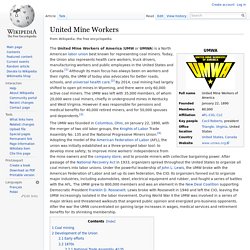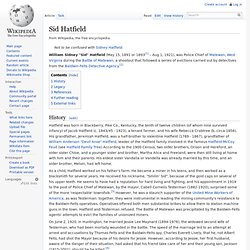

Battle of Blair Mountain. The Battle of Blair Mountain was one of the largest civil uprisings in United States history and the largest armed rebellion since the American Civil War.

For five days in late August and early September 1921, in Logan County, West Virginia, some 10,000 armed coal miners confronted 3,000 lawmen and strikebreakers, called the Logan Defenders, who were backed by coal mine operators during an attempt by the miners to unionize the southwestern West Virginia coalfields. The battle ended after approximately one million rounds were fired,[3] and the United States Army intervened by presidential order.[4] Background[edit] The Battle of Blair Mountain was the result of economic exploitation of workers during a period of social transformation in the southern West Virginia coalfields.
Beginning in 1870–1880, coal operators had established the company town system. By 1920, the United Mine Workers of America (UMWA) organized most of West Virginia. United Mine Workers. The United Mine Workers of America (UMW or UMWA) is a North American labor union best known for representing coal miners.

Today, the Union also represents health care workers, truck drivers, manufacturing workers and public employees in the United States and Canada.[1] Although its main focus has always been on workers and their rights, the UMW of today also advocates for better roads, schools, and universal health care.[2] By 2014, coal mining had largely shifted to open pit mines in Wyoming, and there were only 60,000 active coal miners. The UMW was left with 35,000 members, of whom 20,000 were coal miners, chiefly in underground mines in Kentucky and West Virginia. However it was responsible for pensions and medical benefits for 40,000 retired miners, and for 50,000 spouses and dependents.[3] Coal mining[edit] Development of the Union[edit] Early efforts[edit] American Miners' Association The first step in starting the union was the creation of the American Miners' Association.
John L. Baldwin–Felts Detective Agency. The Baldwin–Felts Detective Agency was a private detective agency in the United States.

Today it is most remembered for its violent confrontations with labor union members in such places as the Pocahantas Coal Field region of West Virginia, the Paint Creek-Cabin Creek strike of 1912 in West Virginia, and in Ludlow, Colorado leading up to the Ludlow Massacre. Formation of the agency[edit] The agency was founded in the early 1890s by William Gibbony Baldwin as the Baldwin Detective Agency. Baldwin, the senior member of the firm, was a native of Tazewell County, Virginia.
An avid reader of detective novels in his youth, Baldwin was a small storekeeper in his early days. Thomas Lafayette Felts was a native of Galax, Virginia, who was educated as a lawyer and was a member of the Virginia Bar Association. By 1913, railroad crimes and associated banditry had decreased and Baldwin–Felts turned to other fields, in particular private security forces for mining companies.
Matewan Massacre[edit] Sid Hatfield. William Sidney "Sid" Hatfield (May 15, 1891 or 1893[1] – Aug 1, 1921), was Police Chief of Matewan, West Virginia during the Battle of Matewan, a shootout that followed a series of evictions carried out by detectives from the Baldwin-Felts Detective Agency.[2] History[edit] Hatfield was born in Blackberry, Pike Co., Kentucky, the tenth of twelve children (of whom nine survived infancy) of Jacob Hatfield (c. 1843/45 - 1923), a tenant farmer, and his wife Rebecca Crabtree (b. circa 1856).

His grandfather, Jeremiah Hatfield, was a half-brother to Valentine Hatfield (1789 - 1867), grandfather of William Anderson "Devil Anse" Hatfield, leader of the Hatfield family involved in the famous Hatfield-McCoy Feud (see Hatfield Family Tree) According to the 1900 Census, two older brothers, Orison and Hereford, an older sister Chloe, and a younger sister and brother, Martha Alice and Freeland, were then still living at home with him and their parents. Legacy[edit] References[edit] Further reading[edit]